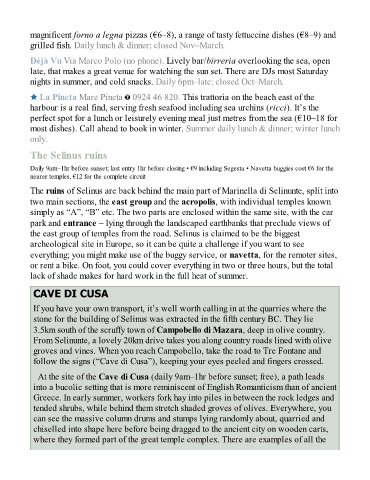Page 538 - The Rough Guide of Sicily
P. 538
magnificent forno a legna pizzas (€6–8), a range of tasty fettuccine dishes (€8–9) and
grilled fish. Daily lunch & dinner; closed Nov–March.
Déjà Vu Via Marco Polo (no phone). Lively bar/birreria overlooking the sea, open
late, that makes a great venue for watching the sun set. There are DJs most Saturday
nights in summer, and cold snacks. Daily 6pm–late; closed Oct–March.
La Pineta Mare Pineta 0924 46 820. This trattoria on the beach east of the
harbour is a real find, serving fresh seafood including sea urchins (ricci). It’s the
perfect spot for a lunch or leisurely evening meal just metres from the sea (€10–18 for
most dishes). Call ahead to book in winter. Summer daily lunch & dinner; winter lunch
only.
The Selinus ruins
Daily 9am–1hr before sunset; last entry 1hr before closing • €9 including Segesta • Navetta buggies cost €6 for the
nearer temples, €12 for the complete circuit
The ruins of Selinus are back behind the main part of Marinella di Selinunte, split into
two main sections, the east group and the acropolis, with individual temples known
simply as “A”, “B” etc. The two parts are enclosed within the same site, with the car
park and entrance – lying through the landscaped earthbanks that preclude views of
the east group of temples from the road. Selinus is claimed to be the biggest
archeological site in Europe, so it can be quite a challenge if you want to see
everything; you might make use of the buggy service, or navetta, for the remoter sites,
or rent a bike. On foot, you could cover everything in two or three hours, but the total
lack of shade makes for hard work in the full heat of summer.
CAVE DI CUSA
If you have your own transport, it’s well worth calling in at the quarries where the
stone for the building of Selinus was extracted in the fifth century BC. They lie
3.5km south of the scruffy town of Campobello di Mazara, deep in olive country.
From Selinunte, a lovely 20km drive takes you along country roads lined with olive
groves and vines. When you reach Campobello, take the road to Tre Fontane and
follow the signs (“Cave di Cusa”), keeping your eyes peeled and fingers crossed.
At the site of the Cave di Cusa (daily 9am–1hr before sunset; free), a path leads
into a bucolic setting that is more reminiscent of English Romanticism than of ancient
Greece. In early summer, workers fork hay into piles in between the rock ledges and
tended shrubs, while behind them stretch shaded groves of olives. Everywhere, you
can see the massive column drums and stumps lying randomly about, quarried and
chiselled into shape here before being dragged to the ancient city on wooden carts,
where they formed part of the great temple complex. There are examples of all the

